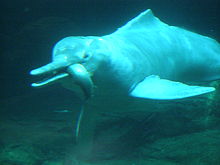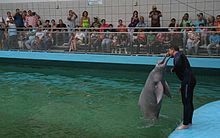- Home >
- Our Actions >
- World report
8
Comments
Monthly Event [Amazon river dolphin] |
|---|
|
by Juvairiyah Batool | 30-06-2020 13:37
|
|
The Amazon river dolphin (Inia geoffrensis), also known as the boto, bufeo or pink river dolphin, is a species of toothed whale classified in the family Iniidae.
The Amazon river dolphin is the largest species of river dolphin, with adult males reaching 185 kilograms (408 lb) in weight, and 2.5 metres (8.2 ft) in length. Adults acquire a pink color, more prominent in males, giving it its nickname "pink river dolphin". Life expectancy of the Amazon river dolphin in the wild is unknown, but in captivity, the longevity of healthy individuals has been recorded at between 10 and 30 years. However, the average longevity in captive animals is only 33 months.An individual named Apure at the Duisburg Zoo, Germany, is estimated to have lived for more than 40 years, being captured from the wild at age nine. The Amazon river dolphin are commonly seen singly or in twos, but may also occur in pods that rarely contain more than eight individuals. Pods as large as 37 individuals have been seen in the Amazon, but average is three. In the Orinoco, the largest observed groups number 30, but average is just above five. During prey time, as many as 35 pink dolphins work together to obtain their prey. The diet of the Amazon river dolphin is the most diverse of the toothed whales. It consists of at least 53 different species of fish, grouped in 19 families. The prey size is between 5 and 80 centimetres (2.0 and 31.5 in), with an average of 20 centimetres (7.9 in). The most frequently consumed fish belong to the families Sciaenidae (croakers), Cichlidae, and Characidae (tetras and piranhas). The dolphin's dentition allows it to access shells of river turtles and freshwater crabs. The diet is more diverse during the wet season, when fish are spread in flooded areas outside riverbeds, thus becoming more difficult to catch. The diet becomes more selective during the dry season when prey density is greater.  Amazon river dolphin feeding Amazon river dolphin feedingLike other dolphins, river dolphins use whistling tones to communicate. The issuance of these sounds is related to the time they return to the surface before diving, suggesting a link to food. Acoustic analysis revealed that the vocalisations are different in structure from the typical whistles of other species of dolphins. Amazon river dolphins are the most widespread river dolphins. They are present in six countries in South America: Bolivia, Brazil, Colombia, Ecuador, Peru, and Venezuela, in an area covering about 7,000,000 square kilometres (2,700,000 sq mi). The boundaries are set by waterfalls, such as the Xingu and Tapajós rivers in Brazil, as well as very shallow water. A series of rapids and waterfalls in the Madeira River have isolated one population, recognized as the subspecies I. g. boliviensis, in the southern part of the Amazon basin in Bolivia.  The main branch of the Amazon River near Fonte Boa, Brazil, with multiple floodplains, lakes and smaller channels. The Amazon river dolphin is observed here throughout the year The main branch of the Amazon River near Fonte Boa, Brazil, with multiple floodplains, lakes and smaller channels. The Amazon river dolphin is observed here throughout the yearThe Amazon river dolphin is located in most of the area's aquatic habitats, including; river basins, major courses of rivers, canals, river tributaries, lakes, and at the ends of rapids and waterfalls. Cyclical changes in the water levels of rivers take place throughout the year. During the dry season, dolphins occupy the main river channels, and during the rainy season, they can move easily to smaller tributaries, to the forest, and to floodplains. Males and females appear to have selective habitat preferences, with the males returning to the main river channels when water levels are still high, while the females and their offspring remain in the flooded areas as long as possible; probably because it decreases the risk of aggression by males toward the young and predation by other species. In the Pacaya-Samiria National Reserve, Peru, photo-identification is used to recognize individuals based on pigmentation patterns, scars and abnormalities in the beak. 72 individuals were recognized, of which 25 were again observed between 1991 and 2000. The intervals between sightings ranged from one day to 7.5 years. The maximum range of motion was 220 kilometres (140 mi), with an average of 60.8 kilometres (37.8 mi). The longest distance in one day was 120 kilometres (75 mi), with an average of 14.5 kilometres (9.0 mi). In a previous study conducted at the center of the Amazon River, a dolphin was observed that moved only a few dozen kilometres from the dry season and wet season. However, three of the reviewed 160 animals were observed over 100 kilometres (62 mi) from where they were first registered. Research in 2011 concluded that photo-identification by skilled operatives using high-quality digital equipment could be a useful tool in monitoring population size, movements and social patterns. The Amazon river dolphin has historically been kept in dolphinariums. Today, only three exist in captivity: one in Acuario de Valencia in Venezuela, one in Zoologico de Guistochoca in Peru, and one in Duisburg Zoo in Germany. Several hundred were captured between the 1950s and 1970s, and were distributed in dolphinariums throughout the US, Europe, and Japan. Around 100 went to US dolphinariums, and of that, only 20 survived; the last died at the Pittsburgh Zoo in 2002. Longstanding threats to Inia include incidental mortality in fishing gear, deliberate killing for fish bait or predator control, damming of rivers, and environmental pollution from organochlorines and heavy metals. Incidental mortality has not been systematically monitored in most areas but is known to be a major threat throughout the species’ range. Similar to other small cetaceans, Inia are vulnerable to entanglement in a variety of nets. They also die in drop traps intended to catch large fish or Amazonian Manatees (Trichechus inunguis) in the flooded forest in Peru. Carcasses of dolphins with evidence of fishery involvement have been observed in the Japurá and Amazon rivers and in the Orinoco River basin.In Tefé, at least 176 dolphins were estimated to have died in 2010 due to interactions with fisheries. Water development projects are another major concern and an increasing threat to Inia. In the Brazilian Amazon alone, 91 dams are planned that, if constructed, would flood about 10 million hectares, representing approximately 2% of the Legal Amazon region and about 3% of the Brazilian portion of the Amazon forest. Added to these, 74 dams are already in operation and 31 are under construction. Over 400 dams could be constructed in the Amazon basin eventually. Chemical contamination is another potential threat to Inia. Mercury is often used to separate gold from soil and rock in mining operations along the Amazon. Indigenous people in some parts of the Amazon may have hunted Inia for food in the past but such hunting is not known to have been common or widespread. In markets around Amazonian cities in Brazil, it is possible to find products labeled as being from Botos, such as eyes and genitals, dry or in perfume solutions, to be used as love charms. This is despite the fact that such commercialization of Inia products violates Federal law. In July 2014, the Federal Government of Brazil published a rule establishing a five-year moratorium on the fishing and marketing of the Piracatinga in Brazilian waters, effective from January 2015, intended to reduce the pressure on dolphins and other wild species used for bait in this fishery. The report of the annual meeting of the International Whaling Commission’s Scientific Committee in 2016 stated: “The Ministry of Environment (MMA) is responsible for evaluating the success of the moratorium. A working group was established by the MMA … to define procedures and monitor the fishing and marketing of piracatinga during the moratorium period. … three inspections to assess compliance with the ban were completed in 2016 and included: ‘Routine Operation’ in the municipalities of Iranduba, Itacoatiara, Manacapurú and Manaus in February, ‘Operation Golden Dragon’ in the municipalities of Maraã, Tefé and Fonte Boa in March-April and ‘Operation Federal Rios’ in the municipalities of Jutaí, Tabatinga, Coari, Fonte Boa and Tefé also in March-April.” The status of Inia has been evaluated in different range states during the last 10 years following the IUCN criteria and those national assessments have classified the species as Endangered. References: https://www.iucnredlist.org/ https://en.wikipedia.org/wiki/Amazon_river_dolphin Pictures: https://www.google.com/?&bih=657&biw=1024&rlz=1C1RLNS_enPK905PK905&hl=en-GB IF YOU WANT TO CONSERVE ENDANGERED SPECIES ALL AROUND THE WORLD, YOU CAN GIVE DONATIONS TO THOSE ORGANIZATIONS WHICH ARE ARE WORKING FOR THIS PURPOSE SUCH AS RED LIST AND MANY MORE. HERE IS THE LINK OF RED LIST: https://www.iucnredlist.org/ TAKE CARE STAY HOME STAY SAFE. GOD BLESS YOU.
|
|
|











 Previous : RED PANDA
Previous : RED PANDA









8 Comments
Greetings juvairiyah
I hope you are doing well
Thank you so much for this report
Keep writing
Green cheers
Regards
Asmita Gaire
Posted 29-09-2020 23:58
Hello,
I hope you are fine and doing good.
Thank you for this informative report
Keep writing.
Green Cheers.
Regards,
Paras Kunwar
Posted 01-08-2020 02:12
Hello Juvairiyah,
It was a wonderful report!
Thanks for sharing.
Eager to learn more from you.
Warm regards,
Asmita
Posted 20-07-2020 18:30
Hello,
This is Bal krishna Pandey from Nepal.
I would like to express my gratitude to you for this wonderful report. It is a good news to read this kind of beautifully written detailed report.
keep writing keep shining
green cheers~
Posted 12-07-2020 19:20
Greetings
I do hope you are all good.
Thank you so much for sharing this report!!
Green cheers
Regards
Jasmine karki
Posted 08-07-2020 15:33
Hello Juvairiyah,
Thank you for letting us know in detail about Dolphin.
Keep Writing.
Green Cheers
Regards,
Shreya Aryal
Posted 02-07-2020 18:23
Hello Juvairiyah
Thank you for your participation in the monthly event!
Posted 02-07-2020 09:10
Hello, juvairiyah
thanks for sharing.
Regards,
Sandesh
Posted 01-07-2020 11:56